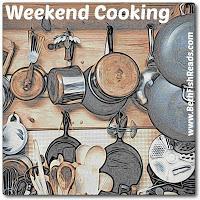Book: Cooked: A Natural History of Transformation by Michael Pollan
Genre: Nonfiction
Publisher: The Penguin Press
Publication date: 2013
Pages: 468
Source: Library
 Summary: Cooked by Michael Pollan looks at the transformation of ingredients into food by the four elemental forces — fire for barbecue, water for braises, air for bread, and earth for fermented products like sauerkraut and cheese.
Summary: Cooked by Michael Pollan looks at the transformation of ingredients into food by the four elemental forces — fire for barbecue, water for braises, air for bread, and earth for fermented products like sauerkraut and cheese.
Thoughts: Did anyone notice that I abandoned my four-part review of Cooked by Michael Pollan after the third part? I got distracted by the release date for Julia Child Rules by Karen Karbo (Book Review: Julia Child Rules by Karen Karbo and Q&A with Karen Karbo, author of Julia Child Rules) and the book club date for The Kitchen Reader (Book Review: Plate to Pixel by Helene Dujardin).
Here are my first three parts of a review of Cooked:
- Book Review: Cooked by Michael Pollan (Part 1), about barbecue with interesting observations about race in America.
- Book Review: Cooked by Michael Pollan (Part 2), about braising with interesting observations about gender and cooking.
- Book Review: Cooked by Michael Pollan (Part 3), about baking bread
Part 4 is about fermentation and it was the most inspiring part for me to make a change in my kitchen. It turns out that the war we humans have been waging on bacteria for the past century had a very harmful effect — the good bacteria in our gut is under siege. We no longer have the diversity or quantity that our ancestors had and it turns out those bacteria are vital to our health.
In fact, the whole way we think of the human organism is changing:
To their surprise, microbiologists discovered that nine of every ten cells in our bodies belong not to us, but to these microbial species (most of them residents of our gut), and that 99 percent of the DNA we’re carrying around belongs to those microbes. Some scientists, trained in evolutionary biology, began looking at the human individual in a humbling new light: as a kind of superorganism, a community of several hundred coevolved and interdependent species. p. 323
Of most interest to me, these microflora may influence weight regulation. Obese individuals have different bacteria in their gut than slim ones. There is also evidence of a probiotic species that produced lower stress levels in mice.
Studies like this one make you wonder if it might someday be possible to cultivate, or garden, our microbiota, altering its makeup to improve our physical and possibly also our mental well-being. pp. 328, 329
I’m fascinated by the idea that I could cultivate a healthy and diverse crop of microflora in my gut and that the effort might result in easier weight maintenance, improved mood, reduced allergy symptoms, and other benefits. I already eat yogurt and cheese, but the best way to introduce live-culture foods in my diet might be with sauerkraut and other fermented vegetables. A footnote quote even claims that the case can be made for making your own fermented vegetables so that the bacteria reflect the local strains in your environment, kind of like eating local honey as a way of exposing yourself to the pollen in your area.
Part 4 of Cooked has lovely passages about cheese (which were interesting to read at the same time as this book: The Whole Fromage by Kathe Lison) and beer, but I came away wanting to learn to make my own sauerkraut.
Have you ever fermented vegetables? What book do you suggest as a starting point?

Cooked is the 11th book for my Foodies Read 2013 Challenge – my goal was 14 to 18, so this is still possible.
Look for more cooking posts at Weekend Cooking hosted by Beth Fish Reads.

